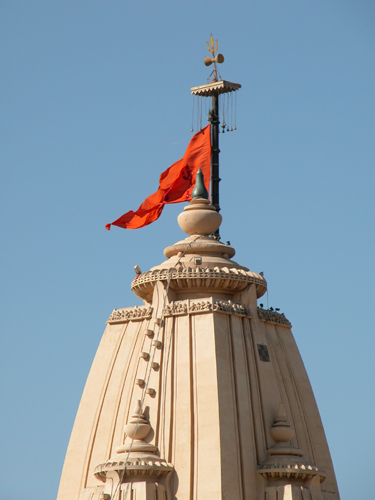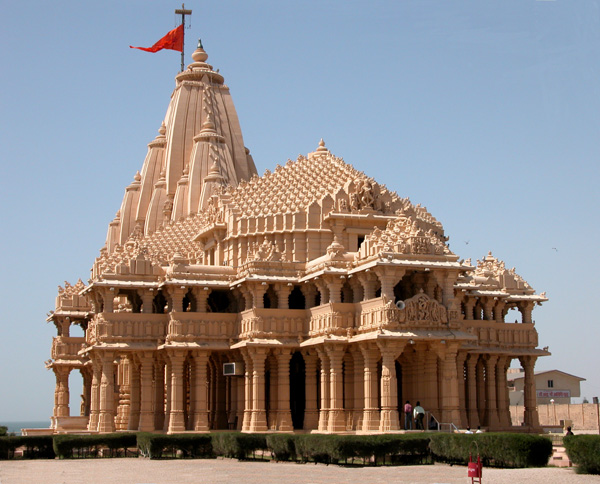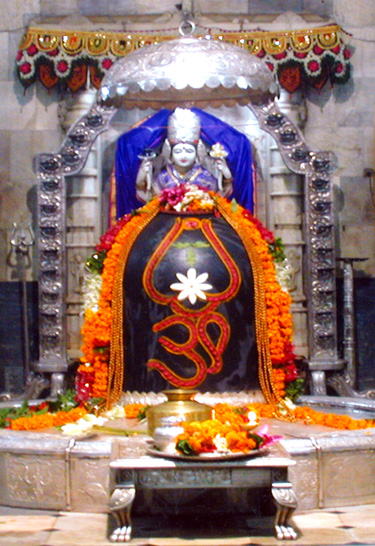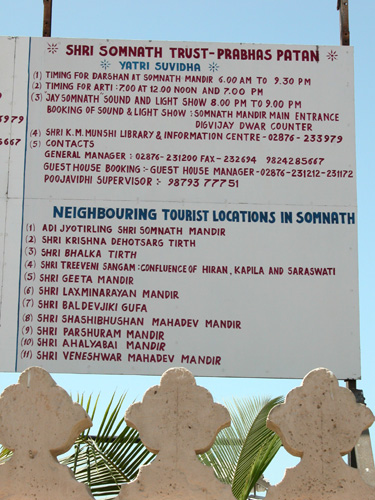 |
The Somnatha Jyotir Lingam Temple, Veraval, Gujarat |
|
|
|
| The Gujarat coastline has been a focal point for traders and invaders for centuries. The Shiva Temple at Somnath, which holds a naturally occurred Jyotir Lingam, has been a landmark to mariners from time immemorial. |
|
|
| South of the temple, on the wall at the sea shore, a pillar is erected. On the top, an arrow is
indicating that between the Somnath Temple and the South Pole there is no landarea only the Arabian Sea and the Indian Ocean. Locals claim that if one were able to sail from here in a straight line, the end of the journey would be the North Pole. |
|
Prabhas
Teerth |
|
The Somnath Jyotir Lingam Temple is situated in the western part of India at the shore of the Indian Ocean near Veraval in Gujarat state. This most sacred and very important pilgrim centre for Hindus, is also called Prabhas Teerth - the Prabhas pilgrimage place. Here it is said, that Lord Shiva ended his incarnated form and returned to his celestial abode. The temple is housing one of the oldest consecrated Jyotir Lingas mentioned in Rigveda, Skanda Purana and Mahabharata. Chandrama, the Moon worshipped Lord Shiva at Prabhas Ksetra hence the name Somnatha which literally means, Lord of Soma (the Moon). The Lord here is also called Somanathar and Someshwar. "Prabhasa" also means, "keen intelligence" At Triveni or Bhalka Teerth, east of the Temple of Somnath, at the confluence of three rivers and on the banks of the river Hiranya, is the spot where Lord Krishna's funeral rites were performed, after a hunter mistook him for a deer and killed him. A large bathing wharf is built here, which is called Dehotsarg. A huge memorial and a Geeta Mandir standing on a number of pillars are also built here. Close by is the very old Surya Mandir, the Sun Temple, which dates back to time of the original Temple of Somnath and gives a clue what the original temple looked like. There is a museum inside the Somnath Temple area and another in a street nearby, that contains relics of the old Somnath Shrines. A small museum inside the Somnath Temple area contains relics from the old Somnath shrine and a photo documentation from the excavation ground. The Prabhas Patan Museum, in the northern main street leading to the temple is interesting to visit. It displays the remaining old building parts and idols from the previous Somnath temples.
|
|
The Somnath Jyotir Lingam Temple |
|
|
|
|
|
History of the Somnath Temple |
|
When the temple were constructed and
who did it, is conclusively and historically not known. In the Skanda Purana's
Prabhas Section a clear description of the holy installation of the Shiva Linga
is available, but there is no mention of the Somnath Temple. A description of the temple by Al-Biruni, an Arab traveller, was so glowing, that it prompted a visit in 1026 by an most unwelcome tourist, Mahmud of Ghazini. At that time the temple was so wealthy that it had 300 musicians, 500 dancing girls and even 300 barbers just to shave the heads of the visiting pilgrims. Mahmud of Ghazini whose raids on the riches of India are legendary, descended on Somnath from his Afghan kingdom and, after a two day battle, took the town and the temple. After having looted its fabulous treasures, he destroyed the temple. It is said that the invaders made off with camel loads of gold and precious gems, leaving the edifice in ruins. The cycle of Muslim destruction and Hindu reconstruction at Somnath continued over the next seven centuries. Totally the temple was destroyed and reconstructed more than 7 times. A photo exhibition in the temple from the excavation, shows several floor levels on top of each other. After the destruction in 1706, the temple was not rebuilt until 1950. After India's Independence a committee was appointed to reconstruct the shrine, called Mahameru Prasad on the exact spot on the shore of the Arabian Sea, where the original temple once was situated. The great freedom fighter, Sardar Vallabhai Patel, played a vital role in the renovation of the temple and there is a sculpture of Sardar Patel at the entrance to the temple. |
|
|
|
|
|
The current temple is built in traditional designs and is a serene symmetrical, sinuous structure. It has a 50m high tower that rises in clusters and can be seen from far away. Sthapathis (Vedic architects) from various parts of India played a role in the renovation process, revealing their skills, adding to the sculptural glory of the temple. In 1951 the Somnatha construction was completed and the sacred installation ceremony of the Shiva Lingam was performed by the president of India. The Somnath Temple was fully completed in 1962. Some cracks appeared as a result of the earthquake in 2001, but they have since been repaired. |
|
|
|
Nearby Somnath is the Sun Temple, the Surya Mandir, which probably dates from the same time as the Temple of Somnath and was laid out in the same fashion. This very old temple, with a frieze of lions with elephant trunks, the sculptures and the doorway give an indication of what the original Somnath Temple was like. |
|
|
|
The Legend about the Moon God |
|
The Somnath Temple is said to have been built out of gold
by Somraj, the Moon God (Soma), of silver by Ravana, by Krishna in
wood and by Bhimdev in stone.
Soma, the Moon God was
wedded to the 27 daughters of Daksha, a son of Brahma, but he loved only one of
them, Rohini. This caused great frustration to the other sisters and an
infuriated Daksha cursed his son-in-law, causing him to loose his lustre. The present temple is recently built (1951) and duplicates its original. In keeping with the legend the stone facade appears golden at sunset. |
|
The Somnatha Jyotir Lingam |
|
|
|
The Somnatha Lingam is one
of the oldest consecrated Jyotir Lingas mentioned in Rigveda,
Skanda Purana and Mahabharata.
The Somnath Linga is considered as the primary and most important of
the 12 Jyotir Lingas, as this deity is Swayanbhu (self-born) and
always awake.
The Somnatha Shiva Lingam has along with the Somnatha Temple been destroyed several times. The ancient Linga, formed spontaneously by the Lord, was scattered in 1026 AD. Another Lingam was installed and destroyed in 1300 AD. The following Lingas were all destroyed.
The present Somnatha Linga is the
largest of the 12 Jyotir Lingas. It is a greyish cylinder formed stone made of
granite about 1m high and 60cm in diameter. The top is rounded and the Lingam is
placed in a large silver plated Yoni. The sacred installation ceremony was
performed in 1951. |
|
History of the Lingam |
| How large was the original Jyotir Lingam?
No definite account can tell us about the original Lingam.
The Somnath Temple has been shattered and rebuilt several times,
but the
original Jyotir Linga stayed on till 1026AD, where this
ancient and most precious Linga, formed
spontaneously by the Lord, were destroyed
by Mahmood Gazani, the Muslim invader. The next installed Linga were vandalised in
1300AD and and the following Jyotir Lingas also.
During an escavation in April 1940 by the
Archeological Department of India the Brahma Shila, Brahma's slab,
were found and the Jyotir Linga were once again fixed on it. |
|
|
|
The speciality of this shrine is that the Linga is always beautifully decorated with crown leaves from various flowers. The Lingam being decorated with leaves from the Lotus flower, offers a rare and beautiful sight for the Darshan seekers. |
|
Darshan |
|
It is possible to have the Darshan
of the Somnatha Lingam daily from early morning when the temple opens to the
last evening rituals and closure of the temple. |
|
Arriving at Somnath |
|
|
|
|
|
|
|
|
|
Situated/how to get there |
| The Somanath Temple is situated 5 km from the city of Veraval in Gujarat. Veraval is the last stop on the railway line from Rajkot, the capital of Gujarat, and busses, taxis, rickshaws are available to reach the holy site. Devotees can stay comfortably in Veraval, but hotels are available adjacent to the Somnatha Temple. The temple has some Dharam Shalas and guesthouses. Busses go to all the major places in the area. |

Vendors at the beach
|
Camel riding - an attraction at the beach |
|
|
|
|
|
|
|
|
|
Prabhas Patan Museum |
|
|
|
Destroyed and plundered by invaders in the medieval ages, phoenix-like
the Somnath Temple resurrected several times from the ashes, its splendour only suffering
in the material used: From gold to silver, from silver to wood and, now, finally stone.
The
Prabhas Patan
Museum, in the northern main street leading to the temple is interesting to visit. It displays the remaining old building parts and idols from the
previous Somnath temples. |
|
|
|
|
|
|
|
|

The present Temple of Somnath in the early morning light

The top in broard daylight
|
|
OM Namah Shivaya
mukti4u2.dk ► created by BP
























